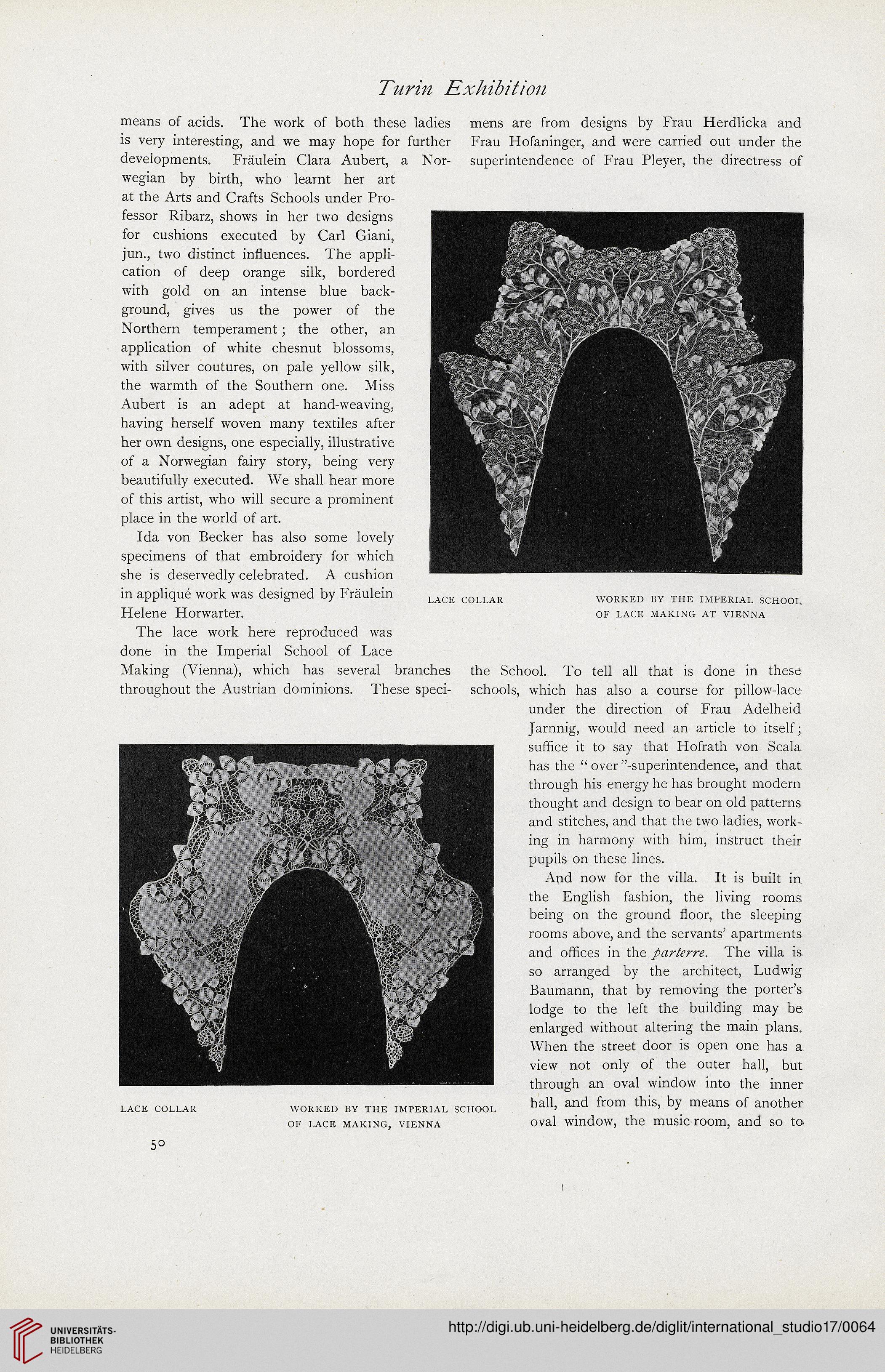Turin Exhibition
means of acids. The work of both these ladies
is very interesting, and we may hope for further
developments. Fraulein Clara Aubert, a Nor-
wegian by birth, who learnt her art
at the Arts and Crafts Schools under Pro-
fessor Ribarz, shows in her two designs
for cushions executed by Carl Giani,
jun., two distinct influences. The appli-
cation of deep orange silk, bordered
with gold on an intense blue back-
ground, gives us the power of the
Northern temperament; the other, an
application of white chesnut blossoms,
with silver coutures, on pale yellow silk,
the warmth of the Southern one. Miss
Aubert is an adept at hand-weaving,
having herself woven many textiles after
her own designs, one especially, illustrative
of a Norwegian fairy story, being very
beautifully executed. We shall hear more
of this artist, who will secure a prominent
place in the world of art.
Ida von Becker has also some lovely
specimens of that embroidery for which
she is deservedly celebrated. A cushion
in applique work was designed by Fraulein
Helene Horwarter.
The lace work here reproduced was
done in the Imperial School of Lace
Making (Vienna), which has several branches
throughout the Austrian dominions. These speci-
LACE COLLAR WORKED BY THE IMPERIAL SCHOOL
OF LACE MAKING, VIENNA
mens are from designs by Frau Herdlicka and
Frau Hofaninger, and were carried out under the
superintendence of Frau Pleyer, the directress of
WORKED BY THE IMPERIAL SCHOOL
OF LACE MAKING AT VIENNA
the School. To tell all that is done in these
schools, which has also a course for pillow-lace
under the direction of Frau Adelheid
Jarnnig, would need an article to itself;
suffice it to say that Hofrath von Scala
has the “ over ’’-superintendence, and that
through his energy he has brought modern
thought and design to bear on old patterns
and stitches, and that the two ladies, work-
ing in harmony with him, instruct their
pupils on these lines.
And now for the villa. It is built in
the English fashion, the living rooms
being on the ground floor, the sleeping
rooms above, and the servants’ apartments
and offices in the pcu-terre. The villa is
so arranged by the architect, Ludwig
Baumann, that by removing the porter’s
lodge to the left the building may be
enlarged without altering the main plans.
When the street door is open one has a
view not only of the outer hall, but
through an oval window into the inner
hall, and from this, by means of another
oval window, the music room, and so to
LACE COLLAR
5°
means of acids. The work of both these ladies
is very interesting, and we may hope for further
developments. Fraulein Clara Aubert, a Nor-
wegian by birth, who learnt her art
at the Arts and Crafts Schools under Pro-
fessor Ribarz, shows in her two designs
for cushions executed by Carl Giani,
jun., two distinct influences. The appli-
cation of deep orange silk, bordered
with gold on an intense blue back-
ground, gives us the power of the
Northern temperament; the other, an
application of white chesnut blossoms,
with silver coutures, on pale yellow silk,
the warmth of the Southern one. Miss
Aubert is an adept at hand-weaving,
having herself woven many textiles after
her own designs, one especially, illustrative
of a Norwegian fairy story, being very
beautifully executed. We shall hear more
of this artist, who will secure a prominent
place in the world of art.
Ida von Becker has also some lovely
specimens of that embroidery for which
she is deservedly celebrated. A cushion
in applique work was designed by Fraulein
Helene Horwarter.
The lace work here reproduced was
done in the Imperial School of Lace
Making (Vienna), which has several branches
throughout the Austrian dominions. These speci-
LACE COLLAR WORKED BY THE IMPERIAL SCHOOL
OF LACE MAKING, VIENNA
mens are from designs by Frau Herdlicka and
Frau Hofaninger, and were carried out under the
superintendence of Frau Pleyer, the directress of
WORKED BY THE IMPERIAL SCHOOL
OF LACE MAKING AT VIENNA
the School. To tell all that is done in these
schools, which has also a course for pillow-lace
under the direction of Frau Adelheid
Jarnnig, would need an article to itself;
suffice it to say that Hofrath von Scala
has the “ over ’’-superintendence, and that
through his energy he has brought modern
thought and design to bear on old patterns
and stitches, and that the two ladies, work-
ing in harmony with him, instruct their
pupils on these lines.
And now for the villa. It is built in
the English fashion, the living rooms
being on the ground floor, the sleeping
rooms above, and the servants’ apartments
and offices in the pcu-terre. The villa is
so arranged by the architect, Ludwig
Baumann, that by removing the porter’s
lodge to the left the building may be
enlarged without altering the main plans.
When the street door is open one has a
view not only of the outer hall, but
through an oval window into the inner
hall, and from this, by means of another
oval window, the music room, and so to
LACE COLLAR
5°




